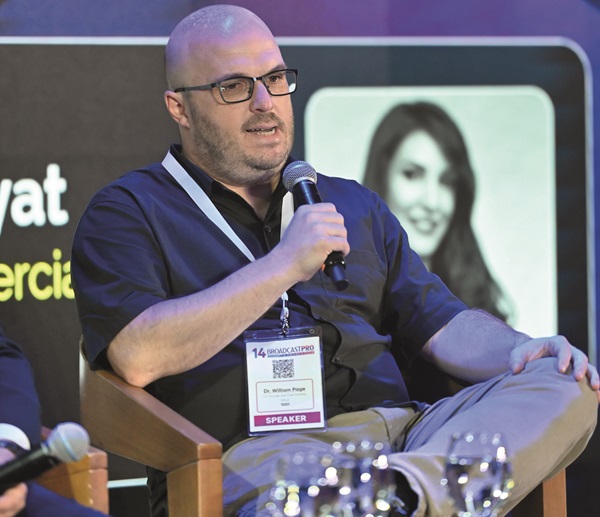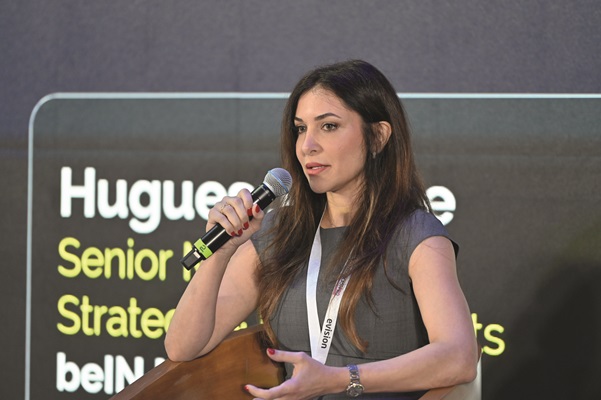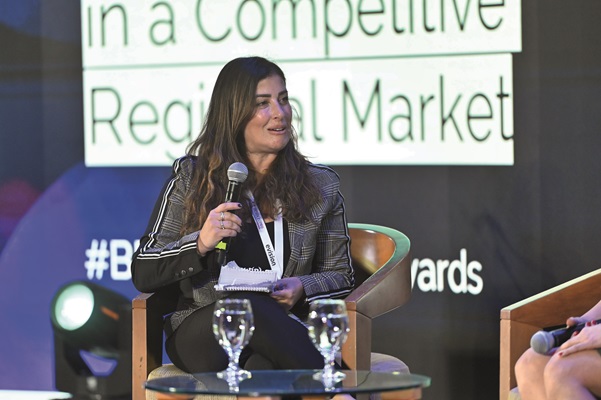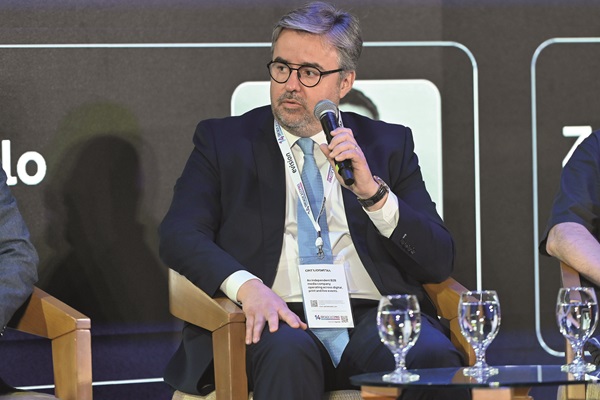No conference is complete without a discussion on monetisation. Our high-profile OTT discussion at the BroadcastPro Summit explored strategies for content localisation, partnerships, collaborations, user engagement, and the integration of e-commerce with entertainment. We bring you the details.
In a burgeoning OTT landscape, content players design and invest in methods that guarantee satisfactory revenue streams and allow customer engagement which promises long-term loyalty. With increased spend on streaming services, local and global platforms harness data to find lucrative avenues to increase retention.
Talking scale and scope, the expert panel moderated by Noor Play’s Chief Commercial Officer, Raghida Abou-Fadel, brought together Hugues Jedele, Senior Manager Strategy and Investments, beIN Media Group; Ramon Bello, Head of TV, Ooredoo Qatar; Dr William Page, co-founder and Chief Strategy Officer, 1001; and Zahra Zayat, Chief Commercial Officer, evision | e& life.
Businesses no longer rely on government backing to optimise products and are instead spending capital to build market share. As content monetisation gets more complicated, Abou-Fadel wished to understand how acquisitions renew revenue paths, and the advantages telecom companies gain from merging with e-commerce portals.
Seeing an opportunity in the market to bridge e-commerce and entertainment, e& life’s acquisition of Careem SuperApp helped its ambition of scaling up consumer digital offerings.

“Beyond the mobile and data services, companies are competing on every aspect of people’s lives for their time and preferences, from booking their taxis and food deliveries to watching their favourite entertainment,” said Zahra Zayat, Chief Commercial Officer, evision | e& life. “With these acquisitions we are closing the loop through our fintech apps Wio Bank and e&money, which allows us to be available and present in people’s lives through every step of their journey throughout the day.
“We wanted to diversify our monetisation strategies across verticals, leverage the use of AI tools and specifically, in the case of evision and e& life, tools that allow customers to scan different products that are available on-screen on the shows and the series and then create a ‘lookalike’ to integrate with multiple e-commerce platforms.”
This ‘lookalike’ extracts products spread across e-commerce platforms and pushes them on-screen for the viewer to shop while watching. Partnering with Trendyol, evision hopes to revamp the retail experience. By offering something new and exciting and allowing people to benefit by buying different products, the idea is to create an end-to-end ecosystem providing monetisation opportunities and customer stickiness.
While driving sales, understanding data opens a range of monetisation opportunities and prospects, not just on engagement but different new verticals. To enhance viewership and retention, content needs to be robust, but from a strategical telecom point of view it is also about enriching people’s digital lifestyles, remarked Ramon Bello, Head of TV, Ooredoo Qatar.

“It sounds a bit legacy, but specifically we are a provider of connectivity. But it’s about going beyond that, which our customers appreciate because they are using our services for entertainment and other broader aspects of their lives.”
When video streaming services first came into the picture, Ooredoo Qatar decided early on to monetise this opportunity, working with them as potential partners and not treating them as competitors. With Ooredoo qualifying as a super aggregator, content is a key pillar of its customer retention strategy and an extremely powerful tool to increase customer lifetime value.
“We aggregate content from multiple sources, whether traditional linear, on-demand, video streaming streaming services … and offer them both bundled with our fixed and mobile products.”
With customers using more content, the company is familiar with data that can go beyond traditional entertainment and video to other adjacencies in gaming, e-commerce, e-learning, e-health and more. From the different strategies applied, bundling has proven most effective and successful for the company. “We sell triple-play to maximise value and our ARPU on the high-end packs where we bundle content is always higher, lowering churn,” said Ramon.

A lot of what’s workable depends on market dynamics, and competitors stay aggressive on the lower tier. For a telco, staying relevant at affordable prices requires understanding what customers value beyond pure connectivity.
Ooredoo Qatar has explored content exclusivity as a tool in the telco space, but owing to its expensive nature, it is employed periodically. “As media providers, we don’t compete with OSN or MBC or Shahid,” said Ramon. “They are our partners, and our ambition is to deliver the most complete entertainment solution to our fixed and mobile services customer.”
To boost monetisation, entertainment platforms often resort to select or special sports content to boost audiences. beIN chose the other way by adding entertainment to its bouquet of sport offerings.
“Sports provides those unique moments, and the 2022 World Cup is a good example of that,” said Hugues Jedele, Senior Manager, Strategy and Investments, beIN Media Group. “But sports marketing is a tough job. You don’t own your IP, you participate in multiple tenders, you need to refresh content all the time and develop a relationship with multiple leagues. And despite long-lasting relationships, sometimes you are challenged by outsiders.”
Apart from the great moments that sport bestows, it is better still to “grow backed by some IP that you own”. And groups such as beIN are very legitimate to build stories that are respectful and resonate with the local culture and viewership and the principles of the region, which some giants are not able to do well. It launched TOD Studios as a label and has since produced Turkish and Arabic series that are available on the streaming platform and linear channels.

“Entertainment is a good retention plan; we see some uptake and more engagement on those content,” said Jedele.
Globally, sports rights holders are looking to sell sports to specific countries as opposed to regions. In theory, the best outcome for leagues is to have organised competition in every single territory where some content is available, though logistically this is demanding.
Some global giants do make worldwide deals, which gives them the vision to develop themselves further. “But we have also noticed that this is mostly happening in the USA, where a large majority of the viewership for such properties is based,” said Jedele.
Regionally, beIN targets specific leagues that appeal to individual countries. “Having built up through step-by-step investment, we are the most reliable partner for leagues because of the geographical coverage we provide, which is beneficial for them. It becomes a grey area when we are the larger partner, but we also remain nicheoriented for ROI,” said Jedele.
Sports creates the real-time urgency to watch that drives subscription, which entertainment is incapable of creating. “It boosts acquisitions and reduces the cost of acquisition per customer. People do come for sports, it increases subscriptions, but not all stay for entertainment, so there’s the question of drop-off,” said Zayat. “People who come for sports content don’t always stay.”

Telcos offer sports as an annual pack and monetise through advertising, sponsorships and subscriptions; even so, the drop-off is difficult to manage, Zayat noted.
“We try to bridge the gap by offering other value-added services, which allows customer stickiness. If we are starting at X and moving to 3X, we must be able to land back at 2X after the sports event and not go back to our initial state. That’s why we’re very selective on sports acquisitions. We did it when it was needed and when it made sense in the market, and when we were able to prove a good return on investment,” said Zayat.
Whether sport or entertainment, all becomes uncertain in volatile regions such as Iraq. Managing the environment with many different models, content pricing and suppliers is challenging, to say the least.
“It is a tough market and piracy in Iraq is practically off the charts,” said Dr William Page, co-founder and Chief Strategy Officer, 1001. “Nearly every major ISP has an illegal platform, and that covers everyone on this panel. So that’s who we are competing with. We are lobbying the government with our partners to introduce legislation to stop this piracy and to bring Iraq to the rest of the region in terms of content.”
Being a very specific new model, 1001 is a super aggregator operating in a market where “everything is free”. But things are looking up, and ISPs such as SuperCell have pushed for deals to legalise how content is streamed in Iraq.
Against this backdrop, monetisation strategies are hard and platforms realise that trying to grow individually is difficult – the only way to break the market is by working together. With a powerful straightforward proposition and multiple content offers that provide good value for money, users are then compelled to say yes to a package.
“We have signed with TOD and beIN, with StarzPlay, OSN, Rotana, and done a number of other direct deals. The reason we have been able to make them is because every one of our partners understands Iraq has the potential to be one of the biggest markets in this region,” said Page.
1001 offers D2C and D2B pricing, the latter based on partnerships with ISPs and telcos. D2C is expensive due to the heavy discounting on D2B.
“We tell the telcos and ISPs to take a 1001 subscription. We do all the back-end technical integration work, provide single sign-on for users to log into Alf W Wahed (1001), and we’re supported by Al Sharqiya, who is the biggest broadcaster in the country,” said Page. “We have a large library of our own and users can see our content. They can also see StarzPlay’s content and Rotana’s content on our app, and users get access to premium content on TOD and beIN and some fantastic shows that OSN carry.”
Sharing revenue with partners over subscriptions and other deals is phenomenal value for money for the users and B2B partners, Page revealed. With a dashboard that gives partners an idea of the market, each platform is aware of its exact positioning and how many activations are being made. Working together to fight piracy, the first signs have been positive in legalising and helping one of the most lucrative markets in the region achieve its potential.
“Sports marketing is a tough job. You don’t own your IP, you participate in multiple tenders, you need to refresh content all the time and develop a relationship with multiple leagues” – Hugues Jedele, Senior Manager Strategy and Investments, beIN Media Group.
Achieving a single sign-on and bringing as much content as possible into one place, simplifying the customer experience with a single relationship, is the common goal, not specific to Iraq. The aim is to build a platform where customers can access all their content without needing to visit multiple platforms, “offering content and simplifying customers’ lives”, said Bello.
B2B sales and partnerships are very important to the growth of activities. On the DTC side, appropriate customer segmentation is necessary to provide flexibility, said Jedele. “We provide the same content to everyone on different levels, depending on affordability – the mobile HD pass and the 4K experience that’s played out on a duration basis, daily, monthly and annual. We use data to target the marketing as accurately as possible to reach out to the good segments.”
The future of OTT (over-the-top) or digital services will essentially involve the integration of data to fine tune interactivity with customers and continuously improve value. This leads to internal ‘platformisation’, where entertainment, e-commerce and other services converge in a digital hub. Supported by platforms, this adds value to the customer experience.
Focusing on futuristic techniques to create value by monetising data is the way forward, rather than relying solely on selling subscriptions and ads. Opening the potential value of customer data and creating a hub that integrates data points from all digital assets into one safe basket, with a lot of encryption, is a space to explore more deeply.
“Our ambition is to deliver the most complete entertainment solution to our fixed and mobile services customer” – Ramon Bello, Head of TV, Ooredoo Qatar.
It’s easier to collect data than to understand what to do with it and how to approach it to benefit other services under the business brand. Doing so safely requires a wholly different set of guidelines.
“If you can see that X operates in a particular space, with affinity to certain products, spending habits, viewing preferences and purchasing power, bridging and matching that data across different services becomes very powerful,” said Zayat. “That’s how we unlock the value of data – securely, of course – while upselling both vertically and horizontally to further boost revenue.
“This encrypted data, when integrated with encrypted data coming from retail media networks and various industries along the chain within a secure environment, becomes a powerful tool. If I’m collecting data from a grocery chain, that ID is available across my other assets, giving me a complete understanding of the customer lifecycle. It’s encrypted and pushed to digital media platforms to facilitate acquisitions and reduce costs. This allows for better customer segmentation, moving from probabilistic data to deterministic data. That’s truly the future.”
Clear audience segmentation gives users a closer, more interested alignment with the advertising they see. AVOD balances revenue but is tough in countries like Iraq where the market is in its infancy. “We try to get advertising to be as specific as we can to the content. AVOD is used at the entry-level to get people into the subscription. It is a combination of blended rates, SVOD and AVOD to strategise profitability,” said Page.
As businesses continue to make data-driven decisions that steer content selection, user engagement and pricing strategies, the future is about giving users more value and better experience. It is about harnessing data to adopt e-sports, e-gaming, e-commerce and other looming possibilities. Furthermore, it is important to change perceptions and not be fixated on subscriptions, to be flexible and open to experimenting different business models and to recognise that one rule doesn’t fit all in an OTT world. And most importantly, to exploit the wealth of partnerships.
















































































